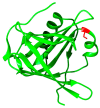Human Anti-Oxidation Protein A1M--A Potential Kidney Protection Agent in Peptide Receptor Radionuclide Therapy
- PMID: 26694383
- PMCID: PMC4691176
- DOI: 10.3390/ijms161226234
Human Anti-Oxidation Protein A1M--A Potential Kidney Protection Agent in Peptide Receptor Radionuclide Therapy
Abstract
Peptide receptor radionuclide therapy (PRRT) has been in clinical use for 15 years to treat metastatic neuroendocrine tumors. PRRT is limited by reabsorption and retention of the administered radiolabeled somatostatin analogues in the proximal tubule. Consequently, it is essential to develop and employ methods to protect the kidneys during PRRT. Today, infusion of positively charged amino acids is the standard method of kidney protection. Other methods, such as administration of amifostine, are still under evaluation and show promising results. α₁-microglobulin (A1M) is a reductase and radical scavenging protein ubiquitously present in plasma and extravascular tissue. Human A1M has antioxidation properties and has been shown to prevent radiation-induced in vitro cell damage and protect non-irradiated surrounding cells. It has recently been shown in mice that exogenously infused A1M and the somatostatin analogue octreotide are co-localized in proximal tubules of the kidney after intravenous infusion. In this review we describe the current situation of kidney protection during PRRT, discuss the necessity and implications of more precise dosimetry and present A1M as a new, potential candidate for renal protection during PRRT and related targeted radionuclide therapies.
Keywords: A1M; PRRT; antioxidation; glomerulus; kidney; octreotide; oxidative stress; radioprotection; tubule.
Figures


References
-
- Bodei L., Mueller-Brand J., Baum R.P., Pavel M.E., Horsch D., O’Dorisio M.S., O’Dorisio T.M., Howe J.R., Cremonesi M., Kwekkeboom D.J., et al. The joint IAEA, EANM, and SNMMI practical guidance on peptide receptor radionuclide therapy (PRRNT) in neuroendocrine tumours. Eur. J. Nucl. Med. Mol. Imaging. 2013;40:800–816. doi: 10.1007/s00259-013-2454-3. - DOI - PMC - PubMed
-
- Valkema R., de Jong M., Bakker W.H., Breeman W.A., Kooij P.P., Lugtenburg P.J., de Jong F.H., Christiansen A., Kam B.L., de Herder W.W., et al. Phase I study of peptide receptor radionuclide therapy with (In-DTPA) octreotide: The rotterdam experience. Semin. Nucl. Med. 2002;32:110–122. doi: 10.1053/snuc/2002.31025. - DOI - PubMed
-
- Kwekkeboom D.J., Krenning E.P., Lebtahi R., Komminoth P., Kos-Kudla B., de Herder W.W., Plockinger U., Mallorca Consensus Conference Participants. European Neuroendocrine Tumor Society Enets consensus guidelines for the standards of care in neuroendocrine tumors: Peptide receptor radionuclide therapy with radiolabeled somatostatin analogs. Neuroendocrinology. 2009;90:220–226. doi: 10.1159/000225951. - DOI - PubMed
Publication types
MeSH terms
Substances
LinkOut - more resources
Full Text Sources
Other Literature Sources

